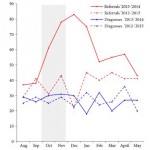Editorial: Be better with public health campaigns (and taxpayers’ money)
In this month’s issue of the BJUI, Hughes-Hallette et al. [1] report on the impact of a mass media public health campaign for gross haematuria. The authors performed a retrospective analysis evaluating the effectiveness of the ‘Be Clear on Cancer: “Blood in the pee”’ campaign. Similar campaigns for colorectal cancer have shown increased referrals and cost, without increasing the number of cancer diagnoses [2, 3]. In the current study [1], cancer diagnosis similarly did not rise. The two questions that therefore needs to be asked are:
- Is gross i.e. visible haematuria a predictor for urological malignancy?
- Does a mass media public health campaign constitue an effective means of improving early diagnosis of cancer?
Recent data from large integrative datasets have shown that visible haematuria is a significant predictor for bladder cancer [4, 5]. If gross haematuria is a predictor for urological malignancy, however, why did the authors [1] fail to find an increase in diagnosis of urological malignancy in their study? While the authors indicate that the study may have been underpowered, and that the use of an unlinked dataset may have interfered with proper accounting of cancer incidence, one must also consider that mass media outreach may not be an effective method for cancer outreach.
The ‘Be Clear on Cancer’ campaign involved the use of television adverts, print media and ‘out of home’ advertisements. Using this method, patients who are at risk of renal and bladder cancer, i.e. men, those aged >50 years, and smokers, are targeted as frequently as non-smoking teenagers. This type of mass media outreach programme is analogous to traditional advertising, where the message is often diluted and ineffective. While the ‘Be Clear on Cancer’ campaign is a worthy endeavour, the data do not seem to support the use of taxpayers’ money given its ineffective nature. A novel approach to visible haematuria may be to encourage GPs to ask patients about visible, painless haematuria, much as they would ask about chest pain or blood pressure. This would create a more focussed and durable outreach programme that would reduce the number of non-oncological referrals. As stewards of taxpayers’ money, we must be careful of how public funds are spent. The next generation of mass media outreach may require a combination of traditional media in addition to, social media and targeted advertising [6]. Although the ‘Be Clear on Cancer’ campaign did not appear to achieve its intended goals at this time, we must continue to refine and create new interactive approaches to improve the diagnosis and treatment of urological malignancies.



